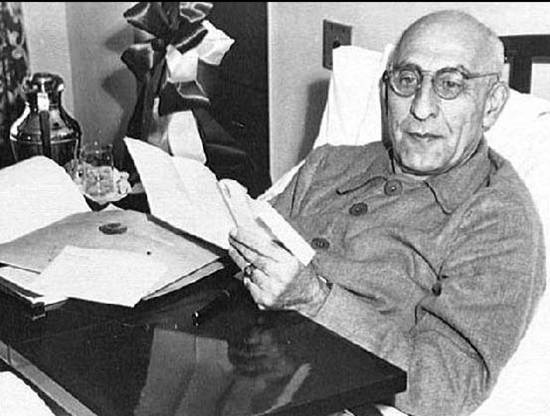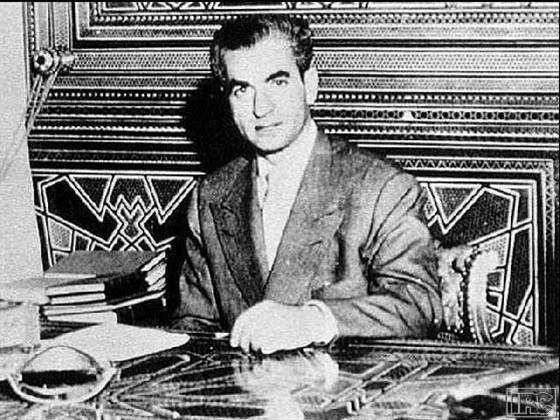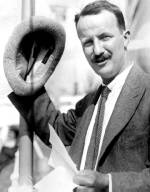"Operation Ajax"
INTRODUCTION
The study of history is open to interpretation, and
interpretations often differ greatly as to what happened and why in any
significant historical event. This assignment examines three secondary accounts
or scholarly interpretations of the CIA-engineered coup in Iran in August 1953
and one declassified primary source, the famed "Wilbur report," a
secret agency account of the events written in 1954 (shortly after the coup) by
one of the CIA's main operatives on the ground in Tehran during the events. The
CIA declassified the "Wilbur report" in 2000, albeit with some of the
information redacted, and it immediately became an invaluable source of
information regarding the coup. A primary goal of this assignment therefore is
to prompt students to think about the differences between primary and secondary
sources in the study of history.
|
|
|
|
|
|
Stephen
Kinzer's book All the Shah's Men (2003) documents the 1953 coup in Iran |
Former Iranian Prime Minister Mohammad Mossadeq
(1882-1967) |
Mohammed
Reza Shah Pahlavi, the "Shah of Iran" (1919-1980) |
CIA agent
Kermit Roosevelt (1916-2000), grandson of Theodore Roosevelt |
Before beginning the assignment view this August 2013 CNN report
on the CIA's release of documents pertaining to its secretive
1953 actions in Iran, kept classified for sixty years, admitting its involvement
in the coup (and remember, sources of this nature are also secondary accounts,
that is, inherently biased sources that interpret
the events described after the fact):
CIA's
1953 "Operation Ajax" (4:29).
|
There
are three steps to this Assignment: Step
1:
Read these three accounts of "Operation Ajax" and look for key
differences between them in content and tone (Note: the directly quoted
descriptions from the texts are in regular font, additional material is
italicized). Each of these secondary sources are from the early 1990s, before the publication of the Wilber
report and other material pertaining to the coup, so the authors did not have access to a great deal of
primary source material in writing these accounts. Thus
their interpretations are based largely on the recollections of the lead CIA
agent in the coup, Kermit [or Kim] Roosevelt, various British intelligence
officers and diplomatic personnel, the Shah, and several eyewitnesses. For a
more recent, comprehensive account of the coup and its aftermath based on
declassified CIA material see Stephen Kinzer's All the Shah's Men: An American Coup and the Roots of Middle East
Terror (2003). |
1.
|
|
Daniel Yergin from The Prize: The Epic Quest for Oil, Money
and Power (1993), pp. 469-470. Yergin, a Pulitzer-prize
winning American author, speaker, and economic researcher, is also co-founder
and Chairman of the Cambridge Energy Research Associates, a consultant group
for major oil companies. In 1993 The Prize aired as a PBS series
which, according to the
media criticism group FAIR, was funded "by Paine Weber, a company
with major oil interests. . . . Almost every expert featured [on the series]
was a defender of the oil industry." |
Yergin asserts that the plan was to have General Fazlollah Zahedi, who was loyal to the Shah, challenge Mossadeq and demand his ouster as Iran's Prime Minister. Yergin's account:
Operation Ajax unfolded over
the middle of August 1953 with great suspense and high drama. There were code
names for all the main actors. The Shah was "Boy Scout"; Mossadeq, "the old bugger." One of [Kermit]
Roosevelt's code names, owing to a border guard who misread his passport, was
"Mr. Scar on Right Forehead." Waiting nervously over several days in
the home of one of his operatives in Tehran, Roosevelt took to playing and
replaying the song "Luck Be a Lady Tonight," from the musical Guys
and Dolls, which was then a great hit on Broadway. It became the theme
song for the operation.
But it looked like bad
luck at the beginning. The operation was scheduled to start when the Shah
issued an order dismissing Mossadeq, but delivery of
the order was delayed three days, by which time Mossadeq
had been tipped off, either by one of his supporters or by Soviet
intelligence. He had the officer who carried the order arrested and
launched his own effort to topple the Shah. General Zahedi went into hiding. Mossadeq's supporters and the Tudeh
[Communist] party held the streets. They smashed and tore down the statues
of the Shah's father in the public squares of Tehran. The Shah himself
took to flight, first to Baghdad, [then to Rome] ...
But the next morning
[August 19] the tide turned in Tehran. General Zahedi held a press
conference at which he handed out photostats of the Shah's order dismissing Mossadeq. A small pro-Shah demonstration grew into a
vast, shouting crowd, led by tumblers doing handsprings and wrestlers showing
off their biceps and giant weightlifters twirling iron bars. Growing even
larger, it swarmed out of the bazaars [markets on the outskirts] to the center
of the city to proclaim its hatred of Mossadeq and
its support for the Shah. Pictures of the Shah suddenly appeared to be
plastered everywhere. Cars turned on their headlights to show support for
the Shah. Though street fights broke out, the momentum was clearly with
the pro-Shah forces. The Shah's dismissal of Mossadeq
and appointment of Zahedi as successor had become known. Key elements of
the military rallied to the Shah, and soldiers and police dispatched to quell
pro-Shah demonstrators instead joined them. Mossadeq
fled over the back wall of his garden, and Tehran now belonged to the Shah's
supporters.
The Shah allegedly said
upon hearing the news in Rome, "I knew that they loved me," referring
to the Iranian people.
2.
|
|
T. E. Vadney from The World Since 1945 (2nd
edition, 1992), pp. 213-214. Vadney
is from Canada and was a Professor of History at the University of Manitoba.
He tends to be very critical of US foreign policy in his textbook. |
Before the coup the US
had supported a [British]-sponsored boycott of Iranian oil on world markets,
and the loss of revenue hurt Mossadeq's government
badly. By late 1952 and early 1953, therefore, the time to strike was
opportune, because Iran was in financial distress. ... Kermit Roosevelt of the
CIA... went to Iran and set the conspiracy in motion. The plan was for the
Shah to dismiss Mossadeq as prime minister, and
install General Zahedi, who had collaborated with the Nazis during the Second
World War. But Mossdadeq found out about the
plot, with the result that the Shah fled first to Baghdad and then to
Rome. Large anti-Shah demonstrations then followed, with the Tudeh [Communist Party] in the vanguard, but the CIA was
also secretly financing demonstrations against Mossadeq's
government. The Prime Minister feared that further violence by his
partisans would cost the government support, and that he was losing control of
events. He therefore called out the army, but it was a right-wing
stronghold. Moreover, calling out the army caused dissension between the Prime
Minister and the Tudeh, and hurt their efforts to
resist the CIA-Shah coup. Instead of protecting Mossadeq's
supporters, the army moved against the crowds of Tudeh
members and other anti-Shah forces. Mossadeq was
overthrown and jailed. The coup had not gone exactly according to plan,
but the result was the same.
Vadney raises several other points as well:
- The net profits of the
Anglo-Iranian Oil Company between 1945 and 1950 were almost three times
the royalties the company paid to Iran, which was one of the main reasons
for strong sentiments against the company.
- When the Parliament
voted to nationalize oil in 1951, he writes, "Popular demonstrations
indicated widespread support for such action," and Mossadeq himself "enjoyed a great deal of
support."
- During Mossadeq's rule, the Communist Tudeh
Party (formerly banned) operated openly, which made the United States
suspicious of the Iranian Prime Minister.
- The Shah attempted to
dismiss Mossadeq in 1952, but popular
demonstrations brought about his return as the Shah backed down.
- After Mossadeq's ouster and the Shah's restoration Iranian
oil remained nationalized; the Shah granted US oil companies an equal
share of the country's oil production to that of the Anglo-Iranian Oil
Company, which previously had controlled almost all of it.
- Western oil companies secretly
agreed to limit Iranian oil production "in order to control the
Shah's revenues and keep him subservient to Western interests."
- Finally, he adds that
"the Shah instituted what became one of the world's most repressive
dictatorships, aided and abetted by the CIA," which created the
Shah's infamous secret police, the SAVAK.
3.
|
|
William Shawcross
from The Shah's Last Ride (1990), pp. 67-71. Shawcross (b. 1948) is a British
free-lance journalist, author, and television commentator known especially
for his work on Southeast Asia. He writes and lectures on international
policy and has written for several publications, including Time, The Washington Post, and Rolling
Stone. He has also authored numerous books on topics ranging from
Cambodia, Iran, and the Nuremburg trials, to a biography of Queen Elizabeth
published in 2009. |
Shawcross repeats the
basic plan for the Shah to dismiss Mossadeq and
replace him with General Zahedi.
Meanwhile,
Roosevelt would give two agents several hundred thousand dollars out of a
substantial slush fund the CIA had established in Tehran. This money was
to be handed out to thugs from athletic clubs and the poor of the South Tehran
slums to encourage them to demonstrate in favor of the Shah....
At first the plan did not go well. Mossadeq
simply arrested the Shah's messenger..., declared that he had forestalled a
coup and issued orders for Zahedi's arrest. But the general was already in
hiding on a friend's estate. He appealed to the Army, still largely loyal
to the Shah. At first, the streets of Tehran were held by Mossadeq supporters and members of the Tudeh
Party. Mobs with red flags tore down the graven images of the Shah's
father, Reza Shah, and cried "Yankees go home."
Thinking the attempt had failed, the Shah himself panicked and fled with [his
wife] Soraya in a small plane to Iraq.... At first the mobs in Tehran had
all been anti-Shah. Gradually, however, the tide began to
turn. Soldiers appeared in the streets and showed that the Army was still
loyal to the Shah and to Zahedi. Then the CIA's paid demonstrators,
organized by Roosevelt's two intelligence brothers, marched up from South
Tehran and shouts "Long live America" began to prevail over
"Yankees go home." The Shah's picture was plastered on walls and
windows. Pro-Shah and anti-Shah groups fought in the streets. Mossadeq was toppled; Zahedi was embraced by the crowds and
assumed the premiership....
Then, drinking champagne with journalists, [the Shah] flew home to a Tehran in
which his supporters had tried to re-erect the toppled statues of his
father. He told Kim Roosevelt of the CIA, "I owe my throne to God, my
people&emdash;and to you."
Many of his opponents considered that the role of the CIA was more crucial than
that of the Almighty. It is certainly true that the actions of the CIA and
MI6 [British intelligence] were important. But alone they could not have
removed Mossadeq. The demonstrations were indeed
provoked and begun with MI6 and CIA money&emdash;no one knows how much was
spent&emdash;but money alone could not adequately explain the way in which
the protests rushed so fast through the city. The costs of Mossadeq's
policies had come to seem too high to too many people and there was already
widespread dissatisfaction with his rule. The CIA and MI6 provided a
spark, but the dry tinder was Iranian. Nonetheless, to many Iranians the
events proved the Shah was an American if not a British puppet.
Shawcross further adds that after the coup replacing Mossadeq with Zahedi, the US approved hefty loans to Iran
that had been on hold since the oil embargo began in 1952. He notes that,
while there was no bloodbath, many of Mossadeq's
supporters were jailed and his foreign minister was executed. Mossadeq lived under house arrest until his death in 1967.
Step 1 (cont'd):
What differences did you notice in these secondary sources? How might one
account for these differences? Respond in 2-4 sentences.






